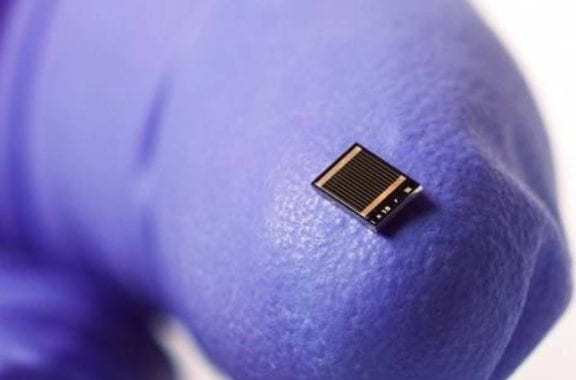A research team in Europe has achieved a world record-setting solar conversion efficiency of 44.7 percent, and assuming that higher efficiency translates into lower costs, it’s yet another indicator that we’re only at the beginning of a long, steep decline in the cost of solar power.
Solar (and wind, for that matter) is already competitive with or cheaper than coal in US markets, and with solar cell efficiency edging this close to the 50 percent efficiency mark, we’re expecting to see those trend lines grow farther and faster in the near future.
44.7% Solar Conversion Efficiency Record
With our usual caveat that there are a number of different solar technologies out there and different ways of measuring conversion efficiency, let’s look at the new record-setting claim.
Record-setting solar cell courtesy of Fraunhofer.
The research partnership consists of the Fraunhofer Institute for Solar Energy Systems ISE, top cutting edge semiconductor manufacturer Soitec, the French R&D organization CEA-Leti, and the Helmholtz Center Berlin.
The basic technology is a multi-junction solar cell, meaning a cell made up of layers of different semiconductor materials in order to capture the widest possible range of the solar spectrum. Multi-junction cells are typically used in concentrator solar systems.
The group of materials used in this particular cell is the III-V group, which refers to their position on the Periodic Table.
The new record is a significant notch up from the team’s previous achievement of 43.6 percent, set just a few months ago. It looks like Soitec made a key contribution in the form of a new bonding process. Fraunhofer ISE Department Head Frank Dimroth explains:
This four-junction solar cell contains our collected expertise in this area over many years. Besides improved materials and optimization of the structure, a new procedure called wafer bonding plays a central role. With this technology, we are able to connect two semiconductor crystals, which otherwise cannot be grown on top of each other with high crystal quality.
The Fraunhofer team better not relax on their laurels, though. They leapfrogged over Sharp, which announced a triple junction cell with 44.4 percent efficiency in the summer, but that doesn’t leave them much breathing room.
Let’s also note for the record that the National Renewable Energy Laboratory (NREL) has been working with the company Amonix to develop a standard for measuring real-world conversion efficiency over a period of time for installed concentrator solar cell systems. Under those calculations, Amonix staked its flag on the world record for CPV systems earlier this year at 35.9 percent.
A Solar Cell In Every Pot
Getting back to the falling cost of solar power, we’ve come a long way from the days when there were solar cells in space and solar cells on your off-the-grid hippie neighbor’s roof, with nothing in between.
Here in the US, aside from supporting improvements in solar cell efficiency, the Obama Administration has also been chipping away at the “soft costs” of installed solar power, which can account for about half the cost of a typical array.
Solar energy is now so ubiquitous that mainstream home builders such as KB Home are now offering models that seamlessly integrate solar power with home EV charging, too.
This story was first published at Cleantechnica. Reproduced with permission.










